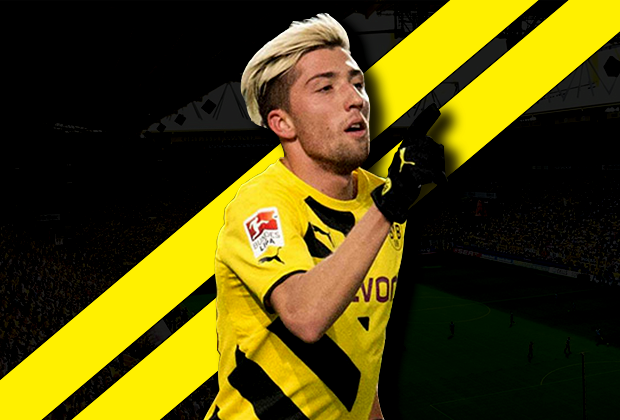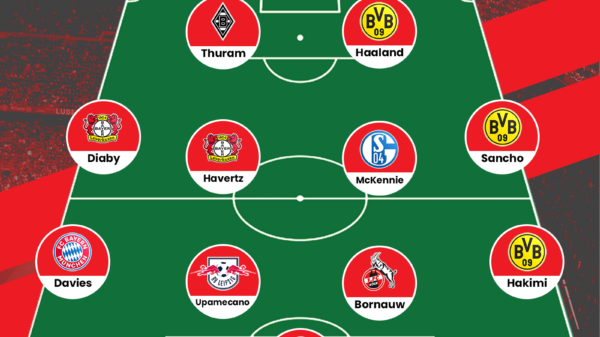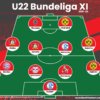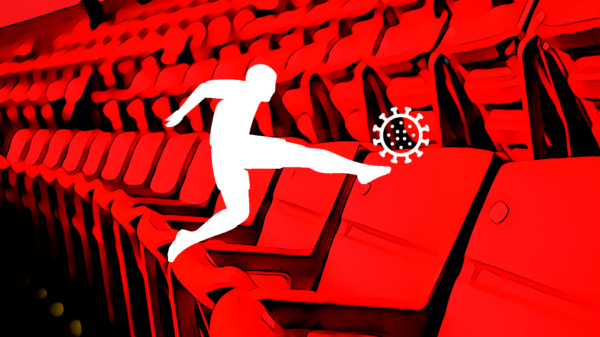After a painful start to the campaign, Borussia Dortmund have found their feet once again, with Slovenian Kevin Kampl playing a large part in the Bundesliga side’s revival; Constantin Eckner explains.
During the winter break, Borussia Dortmund signed Slovenia international Kevin Kampl for a fee of €12 million. The 24-year-old midfielder has shown his dynamic and long-range style at Red Bull Salzburg in recent years. Joining Dortmund after the club had a disastrous first half of the season, Kampl has already become an important element of the reinvigorated side – plus we have to assume his best is yet to come.
A few weeks ago, it was very hard to be optimistic about Borussia Dortmund’s immediate future. The Schwarzgelben sat at the bottom of the Bundesliga table; so when manager Jürgen Klopp announced a promising new signing, it became the only thing to cheer about for the Dortmund faithful.
Trained by now-Leverkusen coach Roger Schmidt in the seasons 2012-13 and 2013-14 at Salzburg, the 24-year-old Kevin Kampl has become what you can call a prototype of a pressing player. As Austrian fans would testify, Kampl has speed, fighting spirit, and along with Sadio Mané, he was the driving force behind a dominant Salzburg side.
Born in Solingen, Germany, Kampl has dual citizenship and would have been eligible to play for Germany but chose Slovenia early on. Kampl started his career in the youth teams of Bayer Leverkusen, yet he played only one match for the first team, ending up in the lower echelons of German football. After a short loan spell at Greuther Fürth and a great season for VfL Osnabrück in the third division, he joined newly promoted second Bundesliga club VfR Aalen for a transfer fee of €250,000 in 2012.
However, he made only four appearances, scoring two goals and assisting another three. This drew the attention of Red Bull Salzburg, who acquired him just before the end of the transfer window in summer 2012. The affluent Austrians activated his buy-out clause for €3 million. Financially, Aalen managed to do a great piece of business, but the second tier side lost a player, who went on to form a dangerous attacking line with Sadio Mané, Alan Carvalho and Jonatan Soriano at Salzburg.
What can he do best?
Kampl is one of a kind, a nimble and agile attacking player with great game intelligence. He wins many duels due to his skill set, with displaying merciless stubbornness in terms of pressing. At the same time, intuition and good vision allow him to be a vital part when it comes to quick attacking combination play.
As already mentioned, he thrived in Roger Schmidt’s team which has been considered as a high pressing, high-octane side. Kampl and Mané formed a vigorous pair of wingers who combined creatively with spectacular dribbling, and defensive strength. Both could use wider spaces as well as tight zones in the attacking third.
Back then, Salzburg usually played a 4-4-2 formation, and the major tool was the movement to use their high press, with the ball near winger moving to press the ball carrier (centre-back). A winger like Kampl arced his run to use his cover shadow to prevent a pass to the full-back, while his teammates made a ball-orientated shift to his side of the field. If the centre-back outplayed Kampl and passed the ball to the left-back, he got involved in isolating the new ball carrier near the side line.
Moreover, Salzburg’s counter pressing was a weapon, similar to the one seen at Dortmund. Immediately after turnovers, they pulled together and tried to win back the ball. The Austrians used a lot of players and shifted extremely aggressively to the ball in order to generate pressure quickly, with Kampl as one of the key players.
In terms of their own build-up play, Salzburg was able to bypass the first third and the front line of the opposing pressing, using the pace of Kampl and Mané to get behind the defence. Consequently, Salzburg played the first passes quickly against compact and high pressing sides. Those passes were often extremely risky, moving so fast that they try to get directly into the opposing midfield or even get behind it. Then again, their great counter pressing came into play, winning incessantly loose balls back.
In other cases, one of Salzburg’s centre backs played a very long ground pass, which bypassed the first two lines of the opposition. For instance, centre forward Soriano let the ball bounce to Kampl, who dribbled and pushed into the open space between the lines.
Regarding Kampl’s possible positions, he played as a right winger under Roger Schmidt, and as a left midfielder in Salzburg’s diamond under AdiHütter in the first half of the current season, while finding himself in a No.10 role for the Slovenian national team. Therefore, Kampl has claimed that he can play in any position in midfield.
What could be his role at Dortmund?
His debut appearance against Leverkusen and the following games have shown that Klopp considers him to play as a winger in Dortmund’s 4-2-3-1 formation. With Henrikh Mkhitaryan struggling at the moment, Kampl can fill in for the Armenian. However, Dortmund’s winter signing has been criticized for his poor and overhasty passing, with an average passing accuracy rate of 55 percent in the first three matches, according to WhoScored.com. This has to be linked with Dortmund’s style of play in those clashes, as the side used many long balls causing wild matches with less structure.
Yet the Mainz match was some kind of a turnaround, because Dortmund played their build-up more calmly. Kampl moved increasingly inward, being a target man for opening passes. On top of this, he assisted Dortmund’s second goal in that match, as centre-back Sokratis Papastathopoulos found him with a great vertical pass, and, after a quick twist, Kampl passed the ball through to Marco Reus who was able to dance round the keeper and put his side in the lead. This goal was textbook Dortmund.
Moreover, Kampl has shown his great work ethic and intensity which suits Dortmund perfectly. During the match against VfB Stuttgart, Klopp had to substitute him due to muscle problems, though, after the young Slovenia international ran 6.28 kilometres and made 20 sprints (according to Bundesliga.com) in the first half.
Dortmund sometimes have the problem that they win the ball via counter pressing high up the pitch, but they do not find space to break into and so cannot use their speed. Kampl is a player who feels comfortable in tight spaces, though. He is able to put together some nice combination plays with the likes of Marco Reus and Shinji Kagawa.
In terms of longer spells of possession, Dortmund tend to attack down the flanks and play the ball diagonally into the final third afterwards – especially on the right side. Kampl might be a key factor within the space between the opposing lines, when he moves inward near Dortmund’s No. 10. Subsequently, he and, for instance, Dortmund’s centre forward Pierre-Emerick Aubameyang are close together and play one-twos to release the speedy Gabonese down the right whenever they can.
Although the likes of Ciro Immobile, Adrián Ramos and Matthias Ginter have all shown how difficult the first year at the club can be, Kampl has quickly thrived in Klopp’s system. He does not seem weighed down by his relatively high price tag. Plenty of promise has been piled on the shoulders of the 24-year-old, and he has lived up to expectations thus far.
Written by Constantin Eckner
- Tactical Philosophy: Thomas Tuchel - July 24, 2015
- Borussia Dortmund: What went wrong? - June 11, 2015
- Why Kevin Kampl has been so important for Dortmund’s revival - March 4, 2015





























































